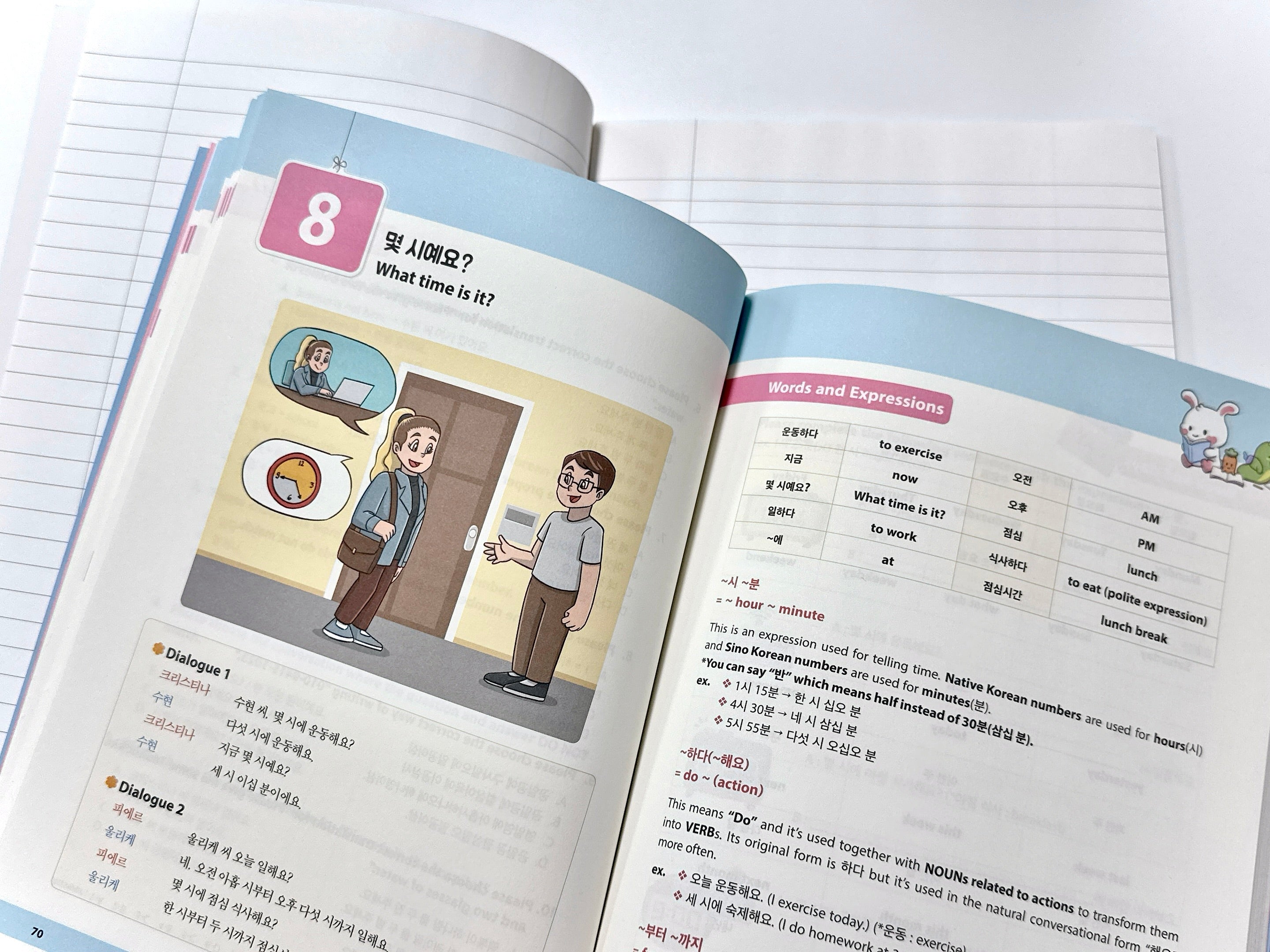Korean For All 1 Chapter 8: Weeks and Days in Korean, ~시 ~분, ~부터 ~까지, Telling time in Korean

How to Ask & Tell Time in Korean!
안녕하세요, 여러분! (Hello, everyone!)
Have you ever needed to ask what time it is in Korean? ⏳
Or maybe you want to say when you eat, work, or study?
Today, we’ll learn:
✅ How to ask and tell the time ⏰
✅ How to use Korean verbs with time
✅ Essential time-related expressions
✅ The 빨리 빨리 (Hurry, hurry) culture in Korea!
1. How to Ask for the Time in Korean
➡️ 몇 시예요? (Myeot si-yeyo?) = "What time is it?"
This is the most common way to ask for the time in Korean.
Example Conversations:
A: 지금 몇 시예요? (Jigeum myeot si-yeyo?) – What time is it now?
B: 세 시 이십 분이에요. (Se si isip bun-ieyo.) – It's 3:20.
2. How to Tell Time in Korean
Koreans use two number systems for telling time:
Native Korean Numbers for Hours (하나, 둘, 셋…)
Sino-Korean Numbers for Minutes (일, 이, 삼…)
🕐 Korean Numbers for Hours
| Hour | Native Korean |
|---|---|
| 1 | 한 시 (Han si) |
| 2 | 두 시 (Du si) |
| 3 | 세 시 (Se si) |
| 4 | 네 시 (Ne si) |
| 5 | 다섯 시 (Daseot si) |
| 6 | 여섯 시 (Yeoseot si) |
| 7 | 일곱 시 (Ilgop si) |
| 8 | 여덟 시 (Yeodeol si) |
| 9 | 아홉 시 (Ahop si) |
| 10 | 열 시 (Yeol si) |
| 11 | 열한 시 (Yeolhan si) |
| 12 | 열두 시 (Yeoldu si) |
⏳ Korean Numbers for Minutes
| Minute | Sino-Korean |
|---|---|
| 10 | 십 분 (Sip bun) |
| 20 | 이십 분 (Isip bun) |
| 30 | 삼십 분 (Samsip bun) |
| 40 | 사십 분 (Sasip bun) |
| 50 | 오십 분 (Osip bun) |
3. Telling Time Examples
1:30 → 한 시 삼십 분 (Han si samsip bun)
4:25 → 네 시 이십오 분 (Ne si isip-o bun)
6:43 → 여섯 시 사십삼 분 (Yeoseot si sasip-sam bun)
4. How to Say AM & PM in Korean
In Korean, AM and PM come before the time!
| English | Korean | Example |
|---|---|---|
| AM | 오전 (Ojeon) | 오전 일곱 시 (7 AM) |
| PM | 오후 (Ohu) | 오후 두 시 (2 PM) |
오전 아홉 시예요. (Ojeon ahop si-yeyo.) – It’s 9 AM.
오후 여섯 시예요. (Ohu yeoseot si-yeyo.) – It’s 6 PM.
5. How to Say When You Do Things
To say when you do something, use ~에 (~e), which means "at" or "on".
🏋️♀️ Example Sentences:
월요일에 운동해요. (Woryoil-e undonghaeyo.) – I exercise on Monday.
한 시에 식사해요. (Han si-e siksa-haeyo.) – I eat at 1 o’clock.
2월에 공부해요. (Iwol-e gongbu-haeyo.) – I study in February.
6. "하다" Verbs – The Easy Way to Make Verbs!
In Korean, you can make verbs by simply adding 하다 (hada) after a noun.
🎯 Common 하다 Verbs:
운동하다 (Undonghada) – To exercise
식사하다 (Siksahada) – To eat (formal)
공부하다 (Gongbuhada) – To study
인사하다 (Insahada) – To greet
말하다 (Malhada) – To speak
💡 Casual Form: Change 하다 to 해요
운동해요 (Undonghaeyo) – I exercise
식사해요 (Siksa-haeyo) – I eat
공부해요 (Gongbu-haeyo) – I study
7. From ___ to ___: 부터 & 까지
부터 (buteo) = "From"
까지 (kkaji) = "Until"
🗓️ Time Examples:
오늘부터 내일까지 (Oneulbuteo nae-ilkkaji) – From today until tomorrow
9시부터 6시까지 일해요. (Ahop si-buteo yeoseot si-kkaji ilhaeyo.) – I work from 9 to 6.
한 시부터 두 시까지 식사해요. (Han si-buteo du si-kkaji siksa-haeyo.) – I eat from 1 to 2.
📍 Location Examples:
여기부터 저기까지 (Yeogibuteo jeogikkaji) – From here to there
1페이지부터 25페이지까지 (Il peiji-buteo isip-o peiji-kkaji) – From page 1 to 25
8. The "빨리 빨리" Culture in Korea
Ever heard Koreans say "빨리 빨리!" (Ppalli ppalli!)?
It means "Hurry, hurry!" and reflects Korea’s fast-paced culture. 🚀
Examples in Daily Life:
✔️ Korea has one of the fastest internet speeds in the world!
✔️ Korean people walk fast and expect quick service at restaurants.
✔️ You’ll often hear "빨리 와!" (Ppalli wa!) – "Come quickly!"
It started after the Korean War when Korea had to rebuild quickly, and today, it still influences business, travel, and daily life!
📝 Practice Time!
Try answering these in Korean:
1️⃣ 지금 몇 시예요? (What time is it now?)
2️⃣ 몇 시에 공부해요? (What time do you study?)
3️⃣ 몇 시부터 몇 시까지 일해요? (From what time to what time do you work?)

Click: Home - With Love From Korea – SooandCarr

Study & Connect via Soo House app
Click: Soo House
-
Posted in
korean grammar, level 1



